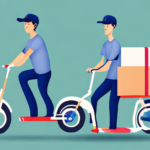Courier charges can make up a significant portion of business expenses, especially for companies that rely heavily on shipping goods. Understanding how these charges are determined can help you minimize your costs and save money. In this comprehensive guide, we'll cover everything you need to know about courier charges, from the basics to hidden fees and surcharges, negotiating with couriers, and more.
The Basics of Courier Charges: A Comprehensive Guide
When you ship a package with a courier service, you're charged a fee based on several factors, including the weight and size of the package, the distance it needs to travel, and the delivery speed. That fee can also vary depending on whether you're shipping domestically or internationally, and what type of item you're sending.
Courier companies offer different types of services, such as same-day or next-day delivery, which come with different charges. Additionally, some courier companies offer discounts for businesses that ship in bulk or regularly use their services. It's important to consider all of these factors when choosing a courier company for your shipping needs.
Another important factor to consider when choosing a courier company is their tracking and insurance policies. Most courier companies offer tracking services that allow you to monitor the progress of your package and ensure that it arrives at its destination on time. Some companies also offer insurance options to protect your package in case it is lost or damaged during transit. Understanding the tracking and insurance policies of the courier company you choose is crucial for safeguarding your shipments.
Factors that Affect Courier Charges
Understanding the factors that affect courier charges can help you make informed decisions when shipping your products. Here are the primary factors to consider:
Weight and Size of the Package
The heavier and bulkier your item, the more you'll have to pay for shipping. Many courier companies use a dimensional weight pricing model, which considers both the size and weight of the package. For more details, refer to the USPS pricing guidelines.
Delivery Speed
Faster delivery options like same-day or next-day services come at a premium cost. If your business can accommodate longer delivery times, opting for standard shipping can lead to significant savings.
Destination
The distance between the origin and destination affects the shipping cost. International shipping generally incurs higher fees due to customs duties, taxes, and longer transit times. Understanding the customs requirements for different countries can also help in estimating costs accurately.
Type of Item Shipped
Special items such as hazardous materials or fragile goods may require additional handling and packaging, resulting in higher shipping fees. Always check with your courier about any special requirements for your items.
How to Calculate Courier Charges for Domestic and International Shipping
Using Online Shipping Calculators
Most courier companies offer online calculators to help you estimate shipping costs based on package dimensions, weight, destination, and desired delivery speed. For example, the FedEx Rate Finder provides detailed cost estimates.
Considering Additional Fees
Be aware of additional fees such as fuel surcharges, residential delivery fees, and customs duties for international shipments. These can significantly impact the total cost of shipping.
Service Options and Insurance
Choosing expedited shipping or adding insurance can increase your costs. Evaluate whether these services are necessary for each shipment to manage expenses effectively.
Hidden Fees and Surcharges You Need to Look Out For When Shipping with Couriers
Common Additional Fees
Courier companies may charge extra for services like signature confirmation, insurance, or weekend delivery. These fees can add up, so it's essential to understand the complete pricing structure.
Fuel Surcharges and Market-Based Fees
Fuel surcharges fluctuate based on market conditions, impacting your shipping costs unpredictably. Some couriers adjust these fees regularly, so staying informed can help you anticipate changes.
Geographic-Specific Fees
Shipping to remote or hard-to-reach areas often incurs additional costs. Always verify with your courier if there are extra charges for specific destinations.
Weight and Size Restrictions
Exceeding the weight or size limits set by couriers can result in overage fees. Ensure your packages comply with the courier’s guidelines to avoid unexpected charges.
Choosing the Right Courier Service to Minimize Shipping Costs
Comparing Prices and Services
Evaluate different courier companies based on their pricing, delivery speed, and reliability. Platforms like UPS Rate Calculator and DPD Business Solutions can help you compare options effectively.
Reliability and Customer Service
Choose a courier known for reliable delivery and excellent customer service. Reliable service can reduce the risk of lost or damaged packages, saving costs in the long run.
Coverage Area
Ensure the courier service you select covers all the regions you need to ship to, both domestically and internationally. Limited coverage may require using multiple couriers, increasing overall costs.
Environmental Considerations
Some couriers offer eco-friendly shipping options, such as carbon-neutral deliveries or the use of electric vehicles. Choosing sustainable shipping can appeal to environmentally conscious customers and may offer long-term savings through efficiency improvements.
Negotiating with Couriers to Get Better Rates for Your Business
Understanding Your Shipping Needs
Before negotiating, assess your shipping volume, destinations, and frequency. Having a clear understanding of your needs allows you to present a strong case for discounts or better terms.
Bulk Discounts and Long-Term Contracts
Many courier companies offer discounts for businesses that commit to shipping a certain volume or sign long-term contracts. This can lead to significant savings over time.
Loyalty Programs
Enrolling in a courier’s loyalty program can provide benefits such as reduced rates, free services, or priority handling, which can help lower your overall shipping costs.
Leverage Multiple Quotes
Gather quotes from multiple couriers to use as leverage in negotiations. Demonstrating that you have competitive offers can encourage couriers to provide more favorable rates.
Tips for Properly Packaging Your Shipment to Avoid Additional Courier Fees
Use Sturdy Packaging Materials
Invest in high-quality packaging materials to protect your items during transit. Using sturdy boxes and protective padding can prevent damage, reducing the need for insurance or replacements.
Optimize Package Size and Weight
Choose packaging that minimizes both size and weight without compromising the safety of your items. Efficient packaging can help you stay within standard rate tiers and avoid overweight charges.
Clear and Accurate Labeling
Ensure all packages are clearly labeled with accurate addresses. Proper labeling helps avoid delivery errors and additional handling fees.
Include Necessary Documentation for International Shipping
For international shipments, include all required customs forms and documentation. Incomplete paperwork can lead to delays, fines, and additional fees.
How Technology is Changing the Landscape of Courier Services and Pricing
Advanced Tracking and Delivery Tools
Technology has enhanced tracking capabilities, allowing businesses and customers to monitor shipments in real-time. Enhanced visibility can improve customer satisfaction and reduce disputes over delivery statuses.
Automation and Robotics
The adoption of automation and robotics in sorting and delivery processes increases efficiency and reduces labor costs, which can translate to lower shipping rates.
Artificial Intelligence and Machine Learning
AI and machine learning optimize delivery routes, predict delivery times, and forecast demand, enabling couriers to offer more accurate pricing and efficient services.
Emerging Technologies: Drones and Autonomous Vehicles
Innovations like drone deliveries and autonomous vehicles have the potential to revolutionize the courier industry by reducing delivery times and operational costs. Monitoring these advancements can help businesses anticipate future changes in shipping costs.
Comparing Prices and Services Across Different Courier Companies
One of the most effective ways to minimize shipping costs is to compare prices and services across various courier companies. Here's how to approach it:
- List Your Shipping Requirements: Determine your typical package sizes, weights, destinations, and delivery speed needs.
- Research Courier Options: Use online tools and calculators provided by companies like FedEx, UPS, and DHL to compare rates.
- Evaluate Service Levels: Consider factors such as reliability, speed, customer service, and tracking capabilities.
- Check for Discounts: Look for available discounts for businesses, such as bulk shipping rates or seasonal promotions.
- Read Reviews and Testimonials: Assess the reputation of couriers based on customer feedback to ensure reliable service.
The Future of Courier Charges: Trends to Watch Out For
The courier industry is continually evolving, influenced by technological advancements and changing market demands. Here are some trends to watch:
Growth of E-commerce
The surge in e-commerce has increased the volume of packages being shipped, driving demand for faster and more efficient courier services. This trend is likely to continue, influencing pricing structures and service offerings.
Gig Economy Impact
The rise of the gig economy has introduced flexible delivery options, such as crowd-sourced deliveries. This can lead to more competitive pricing and innovative service models.
Automation and Cost Reduction
Automation in warehouses and delivery processes can reduce operational costs for couriers, potentially leading to lower shipping rates for businesses.
Sustainability Initiatives
Environmental sustainability is becoming a priority, with couriers investing in green technologies and eco-friendly practices. Businesses may need to balance cost savings with sustainable shipping choices.
Dynamic Pricing Models
Couriers are adopting dynamic pricing models that adjust rates based on real-time factors such as demand, weather conditions, and traffic. Staying informed about these changes can help businesses optimize their shipping strategies.
Case Studies: Real-Life Examples of How Understanding Courier Charges Can Save You Money
Case Study 1: Optimizing Package Dimensions
A small e-commerce business analyzed their packaging and realized they were using boxes that were larger than necessary. By switching to more appropriately sized packaging, they reduced their dimensional weight, lowering their shipping costs by 15%. Proper packaging not only saved money but also improved delivery efficiency.
Case Study 2: Negotiating Bulk Rates
A medium-sized retailer negotiated a long-term contract with a courier service based on their shipping volume. This negotiation resulted in a 10% discount on all shipments, significantly reducing their overall logistics expenses.
Case Study 3: Leveraging Technology for Route Optimization
A logistics company implemented route optimization software powered by AI, which improved their delivery routes and reduced fuel consumption. This technological investment led to a 20% decrease in transportation costs, showcasing the financial benefits of embracing technology.
In conclusion, understanding courier charges is crucial for any business that relies on shipping products. By considering factors such as weight and size, shipping speed, and hidden fees and surcharges, you can choose the right courier service and minimize your shipping costs. Keep an eye on industry trends and consider negotiating with courier companies to get the best rates for your business.




















